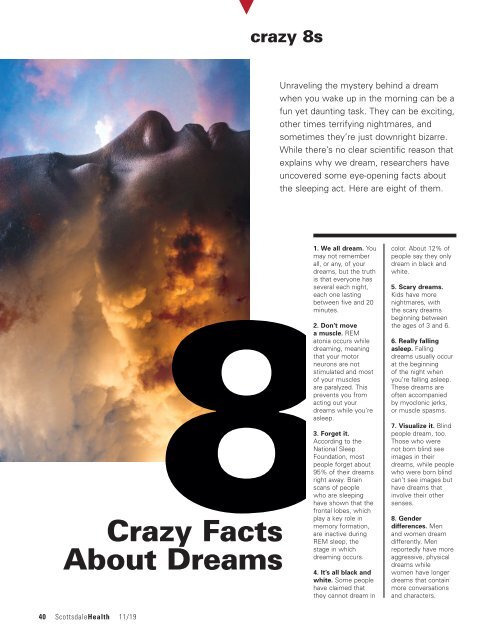Scottsdale Health November 2019
You also want an ePaper? Increase the reach of your titles
YUMPU automatically turns print PDFs into web optimized ePapers that Google loves.
crazy 8s<br />
Unraveling the mystery behind a dream<br />
when you wake up in the morning can be a<br />
fun yet daunting task. They can be exciting,<br />
other times terrifying nightmares, and<br />
sometimes they’re just downright bizarre.<br />
While there’s no clear scientific reason that<br />
explains why we dream, researchers have<br />
uncovered some eye-opening facts about<br />
the sleeping act. Here are eight of them.<br />
Crazy Facts<br />
About Dreams<br />
1. We all dream. You<br />
may not remember<br />
all, or any, of your<br />
dreams, but the truth<br />
is that everyone has<br />
several each night,<br />
each one lasting<br />
between five and 20<br />
minutes.<br />
2. Don’t move<br />
a muscle. REM<br />
atonia occurs while<br />
dreaming, meaning<br />
that your motor<br />
neurons are not<br />
stimulated and most<br />
of your muscles<br />
are paralyzed. This<br />
prevents you from<br />
acting out your<br />
dreams while you’re<br />
asleep.<br />
3. Forget it.<br />
According to the<br />
National Sleep<br />
Foundation, most<br />
people forget about<br />
95% of their dreams<br />
right away. Brain<br />
scans of people<br />
who are sleeping<br />
have shown that the<br />
frontal lobes, which<br />
play a key role in<br />
memory formation,<br />
are inactive during<br />
REM sleep, the<br />
stage in which<br />
dreaming occurs.<br />
4. It’s all black and<br />
white. Some people<br />
have claimed that<br />
they cannot dream in<br />
color. About 12% of<br />
people say they only<br />
dream in black and<br />
white.<br />
5. Scary dreams.<br />
Kids have more<br />
nightmares, with<br />
the scary dreams<br />
beginning between<br />
the ages of 3 and 6.<br />
6. Really falling<br />
asleep. Falling<br />
dreams usually occur<br />
at the beginning<br />
of the night when<br />
you’re falling asleep.<br />
These dreams are<br />
often accompanied<br />
by myoclonic jerks,<br />
or muscle spasms.<br />
7. Visualize it. Blind<br />
people dream, too.<br />
Those who were<br />
not born blind see<br />
images in their<br />
dreams, while people<br />
who were born blind<br />
can’t see images but<br />
have dreams that<br />
involve their other<br />
senses.<br />
8. Gender<br />
differences. Men<br />
and women dream<br />
differently. Men<br />
reportedly have more<br />
aggressive, physical<br />
dreams while<br />
women have longer<br />
dreams that contain<br />
more conversations<br />
and characters.<br />
40 <strong>Scottsdale</strong><strong>Health</strong> 11/19

















